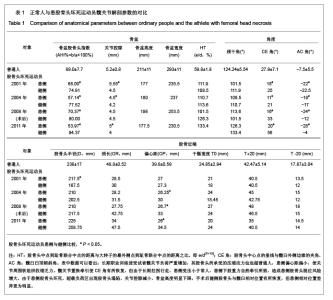| [1] Shi XH,Zheng XY.Beijing:Qinghua Daxue Chubanshe.1990. 时学黄,郑秀媛编译.运动生物力学[M].北京:清华大学出版杜, 1990.[2] Yu XG,Wang Q,Gu JY.Jiujiang Yixue. 2002(4):23-24. 余修贵,王琦,古金耀. 髋关节断层解剖学研究[J]. 九江医学, 2002(4):23-24.[3] Ding Y,Liu SL,Ma RF,et al.Zhongguo Linchuang Jiepouxue Zazhi. 2003,21(4):341-343. 丁悦,刘尚礼,马若凡,等.国人股骨假体设计的解剖学基础[J].中国临床解剖学杂志,2003,21(4):341-343.[4] Fan JG.Kaoshi Zhoukan. 2008;(25):159-160. 范建国.对短跑运动员骨后肌群损伤现状的跟踪调查与对策分析[J].考试周刊,2008,(25):159-160.[5] 吕晓红,邹亮畴,聂文良.D-41运动队绝经后女性身体成分变化影响的追踪调查[C].第十三届全国运动生物力学学术交流大会论文集,浙江:2009,152-153.[6] Wang YJ.Zhonghua Waike Zazhi. 1982;20(5):307. 王以进.骨的生物力学及其临床意义[J].中华外科杂志,1982, 20(5):307.[7] Zheng C,Ma XL,Ma JX,et al.Zhongguo Zhongxiyi Jiehe Waike Zazhi. 2008,14(5):460-461. 郑超,马信龙,马剑雄,等.大鼠股骨颈干角及前倾角的测量[J].中国中西医结合外科杂志,2008,14(5):460-461.[8] Zhao JC,Zhang TL.Beijing:Zhongguo Yiyao Keji Chubanshe. 1992:110-120. 赵炬才,张铁良.髋关节外科学[M].北京:中国医药科技出版社, 1992:110-120.[9] Peng l,Xu CL,Wei LL.CT Lilun yu Yingyong Yanjiu. 2002;(3):12. 彭磊,徐春林,魏莉莉. 螺旋CT三维重建在骨盆骨折中的应用[J]. CT理论与应用研究, 2002,(3):12.[10] Guan JH,Li DH,Zhu Z,et al.Jisuanji Fangzhen. 2004;21 (10):41. 关景火,李德华,朱洲,等.三维全身扫描仪的建模仿真[J].计算机仿真,2004,21 (10):41.[11] Zhang Z,Li J,Gao LB,et al.Zhongguo Xiandai Yisheng 2007; 45(3):14-15. 张志,李健,高良斌,等.股骨偏心距在人工全髋关节置换术中的重要性[J].中国现代医生,2007,45(3):14-15.[12] Ding M, Hvid I. Quantification of age-related changes in the structure model type and trabecular thickness of human tibial cancel-lous bone. Bone.2000;26: 291-295.[13] Wang YJ,Wang JL.Beijing: People’s Mititary Medical Press. 1989:267-278. 王以进,王介麟.骨科生物力学[M].北京:人民军医出版社,1989: 267-278.[14] Wang AY,Peng J,Sun MX,et al.Zhongguo Jiaoxing Waike Zazhi. 2006,14(12):909-911. 汪爱嫒,彭江,孙明学,等.股骨颈骨折病人的股骨头样本结构的Micro -CT评估[J].中国矫形外科杂志, 2006,14(12):909-911.[15] Cao WZ,Wang XL,Ye XE.Zhongguo Shangcan Yixue. 2011; 19(8):20-21. 曹卫众,王晓丽,叶翔尔.股骨头坏死髋关节功能障碍的4步自我疗法疗效观察[J].中国伤残医学,2011,19(8):20-21.[16] Wei CH,Luo SD,Gan XT,et al.Zhongguo Shangcan Yixue. 2011;19(8):85. 韦晨晖,罗世东,甘秀天,等.下地时间对股骨颈骨折术后股骨头坏死的影响[J].中国伤残医学,2011,19(8):85.[17] Lin GY,Huang YD,Liu HT.Zhongguo Shangcan Yixue. 2010;18(2):67-69. 林国叶,黄玉栋,刘航涛.股骨近端解剖型钢板治疗股骨近端骨折[J].中国伤残医学,2010,18(2):67-69.[18] Wei MT,Ji HJ,Li L.Zhongguo Zuzhi Gongcheng Yanjiu yu Linchuang Kangfu. 2010,14(50):9425-9428. 魏梦田,及化娟,李立.足底压力测试技术在不同人群中的应用[J].中国组织工程研究与临床康复,2010,14(50):9425-9428.[19] Qian JG,Song YW,Ye Q,et al.Nanjing Tiyu Xueyuan Xuebao. 2006;5(4):1-7. 钱竞光,宋雅伟,叶强,等.步行动作的生物力学原理及其步态分析[J].南京体育学院学报,2006,5(4):1-7.[20] Song YW,Qian JG,Yue L.Zhongguo Zuzhi Gongcheng Yanjiu yu Linhcuang Kangfu. 2008,18(50):9879-9883. 宋雅伟,钱竞光,岳璐.正常成人裸足与穿普通运动鞋足底压力的比较[J].中国组织工程研究与临床康复,2008,18(50): 9879-9883.[21] Song YW,Cai YX,Kou HJ,et al.Zhongguo Zuzhi Gongcheng Yanjiu yu Linhcuang Kangfu. 2009;13(46):9113-9116. 宋雅伟,蔡奕玺,寇恒静,等.鞋底硬度与人体行走中足底压力的变化[J].中国组织工程研究与临床康复,2009,13(46):9113-9116.[22] Zhu YL.Beijing Renmin Junyi Chubanshe. 2001:154-166. 朱镛连.神经康复学[M].北京:人民军医出版社,2001:154-166.[23] Xu GX,Zhou SF,Lu Q,et al.Zhongguo Yundong Yixue Zazhi. 1997;16(1):29-35. 许光旭,周士枋,卢青,等.步态分析在偏瘫康复评定与治疗中的作用[J].中国运动医学杂志,1997,16(1):29-35.[24] Tao K,Wang DM,Wang CT,et al.Zhongguo Shengwu Yixue Gongcheng Xuebao. 2007;26(5):765-766. 陶凯,王冬梅,王成焘,等.基于三维有限元静态分析的人体足部生物力学研究[J].中国生物医学工程学报,2007,26(5):765-766.[25] Wang YH,Yan L,Yang C,et al.Zhonghua Laonian Yixue Zazhi. 2005;24(10):761-762. 王永慧,严励,杨川,等.不同年龄健康人足底压力参数的比较[J].中华老年医学杂志,2005,24(10):761-762.[26] Xiang ZY.Jishu Zhuankan. 2001;23(11):67-69. 相子元.不同步态慢跑鞋足底压力比较分析[J].技术专刊,2001, 23(11):67-69.[27] Chen X,Zhu YY.Zhongguo Geti Fanghu Zhuangbei. 2006; 19(1):8-11. 陈晓,祖媛媛.军用鞋靴足底压力的舒适性测试分析[J].中国个体防护装备,2006,19(1):8-11.[28] Mao BR,Jia XW,Zheng FR,et al.Zhongguo Jiaoxing Waike Zazhi. 2002;10(12):1211-1213. 毛宾尧,贾学文,郑菲蓉,等.行走和站立时足底应力分布研究[J].中国矫形外科杂志,2002,10(12):1211-1213.[29] Li YX,Liu Y,Han T,et al.Zhongguo Zuzhi Gongcheng Yanjiu yu Linchuang Kangfu. 2008,12(15):2870-2874. 李艳霞,刘颖,韩涛,等.肥胖青年平地自然行走时足底压力分析与步态特征[J].中国组织工程研究与临床康复,2008;12(15):2870- 2874.[30] Luo J.Zhongguo Zuzhi Gongcheng Yanjiu yu Linchuang Kangfu. 2007;11(9):1734-1737. 罗炯.足底压力分布测量技术的应用特点[J].中国组织工程研究与临床康复,2007,11(9):1734-1737. |

